Related Research Articles
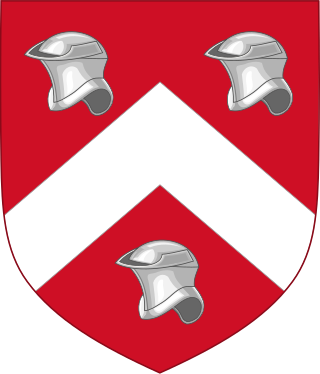
Sir Owen Tudor was a Welsh courtier and the second husband of Queen Catherine of Valois (1401–1437), widow of King Henry V of England. He was the grandfather of Henry VII, founder of the Tudor dynasty.

Addington Palace is an 18th-century mansion in Addington located within the London Borough of Croydon. It was built close to the site of an earlier manor house belonging to the Leigh family. It is particularly known for having been, between 1807 and 1897, the summer residence of the Archbishops of Canterbury. Since the 1930s most of the grounds have been occupied by Addington Palace Golf Club. Between 1953 and 1996 the mansion was occupied by the Royal School of Church Music. It was later used as a wedding and events venue.

Fulham is an area of the London Borough of Hammersmith & Fulham in West London, England, 3.6 miles (5.8 km) southwest of Charing Cross. It lies on the north bank of the River Thames, bordering Hammersmith, Kensington and Chelsea. The area faces Wandsworth, Putney, Barn Elms and the London Wetland Centre in Barnes. on the far side of the river.
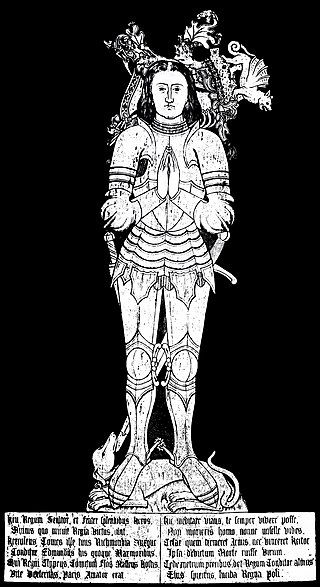
Edmund Tudor, 1st Earl of Richmond, was the father of King Henry VII of England and a member of the Tudor family of Penmynydd. Born to Sir Owen Tudor and the dowager queen Catherine of Valois, Edmund was the half-brother of Henry VI of England. He was raised for several years by Katherine de la Pole and Henry took an interest in Edmund's upbringing, granting him a title and lands once he came of age. Both Edmund and his brother, Jasper, were made advisers to the King, as they were his closest remaining blood relatives.

The Palace of Placentia, also known as Greenwich Palace, was an English royal residence that was initially built by Humphrey, Duke of Gloucester, in 1443. The palace was a place designed for pleasure, entertainment and an escape from the city. It was located at Greenwich on the south bank of the River Thames, downstream from London. On a hill behind the palace he built Duke Humphrey's Tower, later known as Greenwich Castle; it was subsequently demolished to make way for the Royal Observatory, Greenwich, which survives. The original river-side residence was extensively rebuilt around 1500 by Henry VII. A detached residence, the Queen's House, was built on the estate in the early 1600s and also survives. In 1660, the main palace was demolished by Charles II to make way for a proposed new palace, which was never constructed. Nearly forty years later, the Greenwich Hospital was built on the site.
Much Hadham, formerly known as Great Hadham, is a village and civil parish in the district of East Hertfordshire, Hertfordshire, England. The parish of Much Hadham contains the hamlets of Perry Green and Green Tye, as well as the village of Much Hadham itself and Hadham Cross. It covers 4,490 acres (1,820 ha). The village of Much Hadham is situated midway between Ware and Bishop's Stortford. The population of the parish was recorded as 2,087 in the 2011 census, an increase from 1,994 in 2001.

Sawbridgeworth is a town and civil parish in Hertfordshire, England, close to the border with Essex. It is 12 miles (19 km) east of Hertford and 9 miles (14 km) north of Epping. It is the northernmost part of the Greater London Built-up Area.
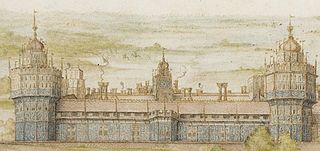
Nonsuch Palace was a Tudor royal palace, commissioned by Henry VIII in Surrey, England and completed in 1538. Its site lies in what is now Nonsuch Park on the boundaries of the borough of Epsom and Ewell in Surrey and the London Borough of Sutton.

Fulham Palace, in Fulham, London, previously in the former English county of Middlesex, is a Grade I listed building with medieval origins and was formerly the principal residence of the Bishop of London. The site was the country home of the bishops from the 11th century until 1973. Though still owned by the Church of England, the palace, managed by the Fulham Palace Trust, houses a number of restored historic rooms and a museum documenting its long history. The property resides next to Bishops Park and contains a large botanic garden. The palace garden is ranked Grade II* on the Register of Historic Parks and Gardens.

Hertford and Stortford is a constituency currently represented in the House of Commons of the UK Parliament since 2019 by Julie Marson of the Conservative Party.
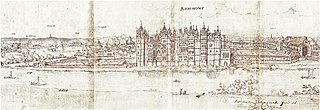
Richmond Palace was a royal residence on the River Thames in England which stood in the sixteenth and seventeenth centuries. Situated in what was then rural Surrey, it lay upstream and on the opposite bank from the Palace of Westminster, which was located nine miles (14 km) to the north-east. It was erected in about 1501 by Henry VII of England, formerly known as the Earl of Richmond, in honour of which the manor of Sheen had recently been renamed "Richmond". Richmond Palace therefore replaced Shene Palace, the latter palace being itself built on the site of an earlier manor house which had been appropriated by Edward I in 1299 and which was subsequently used by his next three direct descendants before it fell into disrepair.

Oatlands Palace is a former Tudor and Stuart royal palace which took the place of the former manor of the village of Oatlands near Weybridge, Surrey. Little remains of the original building, so excavations of the palace took place in 1964 to rediscover its extent.

Little Hadham is a village and civil parish in the district of East Hertfordshire, Hertfordshire, England. At the census of 2001 it had a population of 1,081, increasing to 1,153 at the 2011 Census. It is bypassed by the A120 road, which connects it to the nearby town of Bishop's Stortford. The civil parish includes the hamlets of Bury Green, Church End, Cradle End, Green Street and Hadham Ford. Little Hadham, together with the neighbouring village of Much Hadham, are collectively known as The Hadhams.

Hadham Rural District was a rural district in Hertfordshire, England from 1894 to 1935, covering an area in the east of the county.

Sundridge is a village within the civil parish of Sundridge with Ide Hill, in the Sevenoaks district of Kent, England. The village is located on the A25 road to the east of Westerham. It lies within the Kent Downs Area of Outstanding Natural Beauty and within London’s Metropolitan Green Belt. It is approximately 21 miles south of London. Its church is Anglican and dedicated to St Mary.
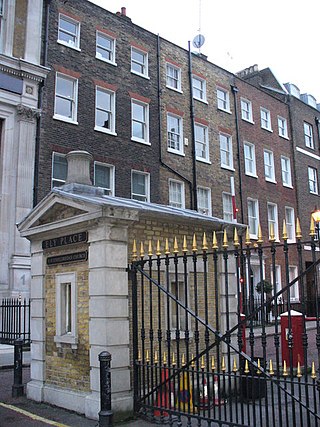
Ely Place is a gated road of multi-storey terraces at the southern tip of the London Borough of Camden in London, England. It hosts a 1773-rebuilt public house, Ye Olde Mitre, of Tudor origin and is adjacent to Hatton Garden.
Doughty House is a large house on Richmond Hill in Richmond, London, England, built in the 18th century, with later additions. It has fine views down over the Thames, and both the house and gallery are Grade II listed buildings. This view from Richmond Hill is the only view in England protected by an Act of Parliament.

Kings Langley Palace was a 13th-century Royal Palace which was located to the west of the Hertfordshire village of Kings Langley in England. During the Middle Ages, the palace served as a residence of the Plantagenet kings of England. It fell into disuse sometime during the 16th century and became a ruin. Today, nothing remains of the building except for some archaeological remains. The site is a scheduled ancient monument.

St Edmund's Church is the Roman Catholic parish church of Godalming, a town in the English county of Surrey. It was built in 1906 to the design of Frederick Walters and is a Grade II listed building. The church stands on a "dramatic hillside site" on the corner of Croft Road just off Flambard Way close to the centre of the town.

Loughton Hall is a large house in Rectory Lane, Loughton, Essex. The architect was William Eden Nesfield, and it is grade II listed with Historic England. It is now a 33-bedroom residential care home for elderly people.
References
- ↑ "Bishops Folly The Palace The Palace East The Palace West". Historic England. Retrieved 27 December 2015.
- 1 2 3 "Much Hadham - The Palace" . Retrieved 10 August 2013.
- ↑ "Sir Edmund Tudor, 1st Earl of Richmond". Archived from the original on 30 January 2016. Retrieved 10 August 2013.
- ↑ "1937 Rolls-Royce 25/30 Barker Limousine" . Retrieved 10 August 2013.
- ↑ "Palace House, Much Hadham". Archived from the original on 11 August 2013. Retrieved 10 August 2013.